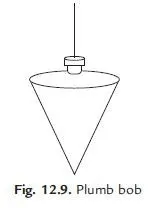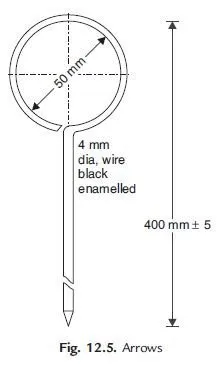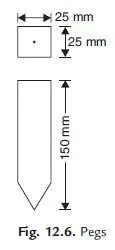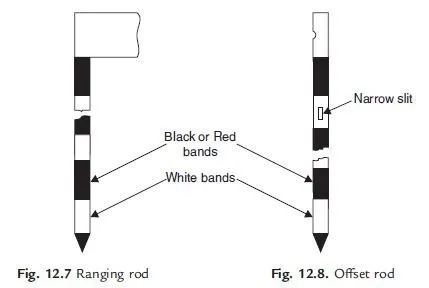The following instruments are required for measurements with chain and tape:
(i) Arrows
(ii) Pegs
(iii) Ranging rods and ranging poles
(iv) Offset rods
(v) Laths
(vi) Whites
(vii) Plumb bobs and
(viii) Line ranger.
Arrows
When the length of the line to be measured is more than a chain length, there is need to mark the end of the chain length. Arrows are used for this purpose. A typical arrow is shown in Fig. 12.5. Arrows are made up of 4 mm diametered steel wire with one end sharpened and other end bent into a loop. Length of an arrow is approximately 400 mm.
Pegs
Wooden pegs are used in measuring a length of a line to mark the end points of the line. The pegs are made of hard wood of 25 mm × 25 mm section, 150 mm long with one end tapered as shown in Fig. 12.6. When driven in ground to mark station points they project about 40 mm.
Ranging Rods and Ranging Poles
For ranging intermediate points along the line to be measured, ranging rods and ranging poles are used.
Ranging rods are 2 to 3 m long and are made of hard wood. They are provided with iron shoe at one end as shown in Fig. 12.7.
They are usually circular in section with 30 mm diameter and are painted with 200 mm colour bands of red and white or with black and white. If distance is more than 200 m, for clear visibility they may be provided with multicoloured flags at their top. The ranging rods are occasionally used to measure
short distances since they are painted with alternate colour of band 200 mm.
Ranging poles are similar to ranging rods except that they are longer. Their length varies from 4 m to 8 m and diameter from 60 mm to 100 mm. They are made of hard wood or steel. They are fixed in the ground by making 0.5 m holes and then packed to keep them vertical.
Offset Rods
These rods are also similar to ranging rods and they are 3 m long. They are made up of hard wood and are provided with iron shoe at one end. A hook or a notch is provided at other end. At height of eye, two narrow slits at right angles to each other are also provided for using it for setting right angles. A typical offset rod is shown in Fig. 12.8.
Laths
Laths are 0.5 to 1.0 m long sticks of soft wood. They are sharpened at one end and are painted with
white or light colours. They are used as intermediate points while ranging or while crossing depressions.
Whites
Whites are the pieces of sharpened thick sticks cut from the nearest place in
the field. One end of the stick is sharpened and the other end is split. White papers are inserted in the split to improve the visibility. Whites are also used for the same purpose as laths.
 Plumb Bob
Plumb Bob
A typical plumb bob is shown in Fig. 12.9. In measuring horizontal distances
along sloping ground plumb bobs are used to transfer the position to ground.
They are also used to check the verticality of ranging poles.
Line Ranger
It is an optical instrument used for locating a point on a line and hence useful for ranging. It consists of two isosceless prisms placed one over the other and fixed in an instrument with handle. The diagonals of the prisms are silvered so as to reflect the rays.
To locate point C on line AB (ref. Fig. 12.10) the surveyor holds the instrument in hand and stands near the approximate position of C. If he is not exactly on line AB, the ranging rods at A and B appear separated as shown in Fig. 12.10 (b). The surveyor moves to and fro at right angles to the line AB till the images of ranging rods at A and B appear in a single line as shown in Fig. 12.10 (c). It happens only when the optical square is exactly on line AB. Thus the desired point C is located on the line AB.
Its advantage is it needs only one person to range. The instrument should be occasionally tested by marking three points in a line and standing on middle point observing the coincidence of the ranging rods. If the images of the two ranging rods do not appear in the same line, one of the prism is adjusted by operating the screw provided for it.
What is offset rod in surveying:
In surveying, an offset rod, also referred to as a boning rod, is a simple yet indispensable tool employed to measure short perpendicular distances from a survey line to a specific point or object. These rods, typically crafted from wood or fiberglass, are distinguished by their unadorned appearance, devoid of the markings or flags found on ranging rods.
Functionality
Surveyors establish a reference line using ranging rods, then position the offset rod perpendicularly at the desired point. The distance between the survey line and the offset rod, measured with a tape or other instrument, constitutes the offset. This enables the surveyor to accurately map the location of objects relative to the established baseline.
Advantages
- Simplicity: Offset rods are straightforward to use and easily portable, making them a convenient tool for field surveys.
- Accuracy: Despite their simplicity, offset rods can provide precise measurements, particularly for short distances, typically within a few meters.
- Efficiency: They enable surveyors to quickly and efficiently measure multiple offsets along a survey line, saving valuable time and effort.
Limitations
- Limited Range: Offset rods are primarily suitable for measuring short distances. For longer offsets, surveyors often employ alternative methods like taping or utilizing electronic distance measurement (EDM) devices.
Offset rods are a valuable asset in a surveyor’s toolkit, especially when mapping smaller areas or detailing features in close proximity to a survey line. Their simplicity, accuracy, and efficiency make them a practical choice for a wide range of surveying applications.




I like this information.its easy and nice….,…
what are the instruments in surveying and their uses?
Thanks, I like this, this is very helpful to my assignment